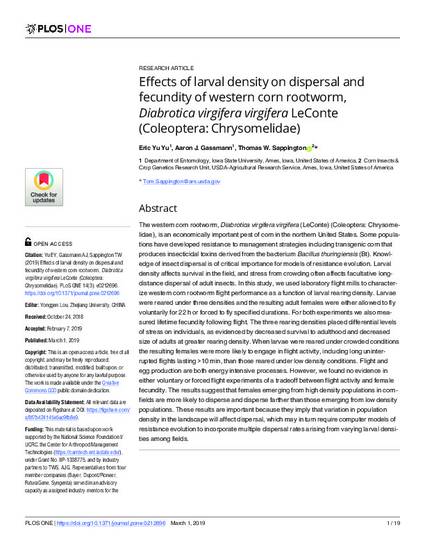
The western corn rootworm, Diabrotica virgifera virgifera (LeConte) (Coleoptera: Chrysomelidae), is an economically important pest of corn in the northern United States. Some populations have developed resistance to management strategies including transgenic corn that produces insecticidal toxins derived from the bacterium Bacillus thuringiensis (Bt). Knowledge of insect dispersal is of critical importance for models of resistance evolution. Larval density affects survival in the field, and stress from crowding often affects facultative long-distance dispersal of adult insects. In this study, we used laboratory flight mills to characterize western corn rootworm flight performance as a function of larval rearing density. Larvae were reared under three densities and the resulting adult females were either allowed to fly voluntarily for 22 h or forced to fly specified durations. For both experiments we also measured lifetime fecundity following flight. The three rearing densities placed differential levels of stress on individuals, as evidenced by decreased survival to adulthood and decreased size of adults at greater rearing density. When larvae were reared under crowded conditions the resulting females were more likely to engage in flight activity, including long uninterrupted flights lasting >10 min, than those reared under low density conditions. Flight and egg production are both energy intensive processes. However, we found no evidence in either voluntary or forced flight experiments of a tradeoff between flight activity and female fecundity. The results suggest that females emerging from high density populations in cornfields are more likely to disperse and disperse farther than those emerging from low density populations. These results are important because they imply that variation in population density in the landscape will affect dispersal, which may in turn require computer models of resistance evolution to incorporate multiple dispersal rates arising from varying larval densities among fields.
Available at: http://works.bepress.com/aaron_gassmann/80/

This article is published as Yu EY, Gassmann AJ, Sappington TW (2019) Effects of larval density on dispersal and fecundity of western corn rootworm, Diabrotica virgifera virgifera LeConte (Coleoptera: Chrysomelidae). PLoS ONE 14(3): e0212696. doi: 10.1371/journal.pone.0212696.